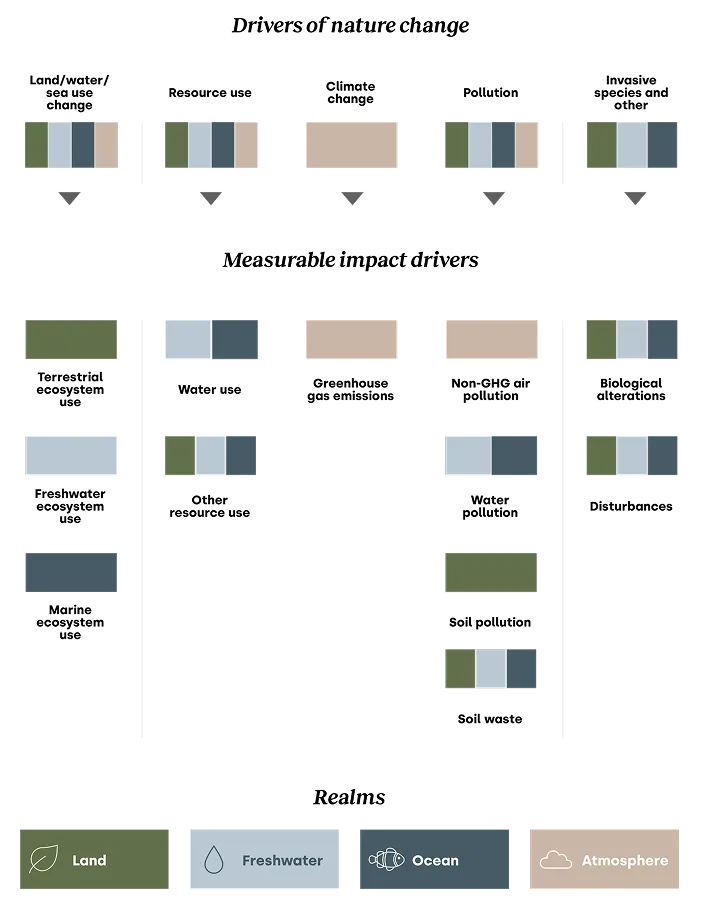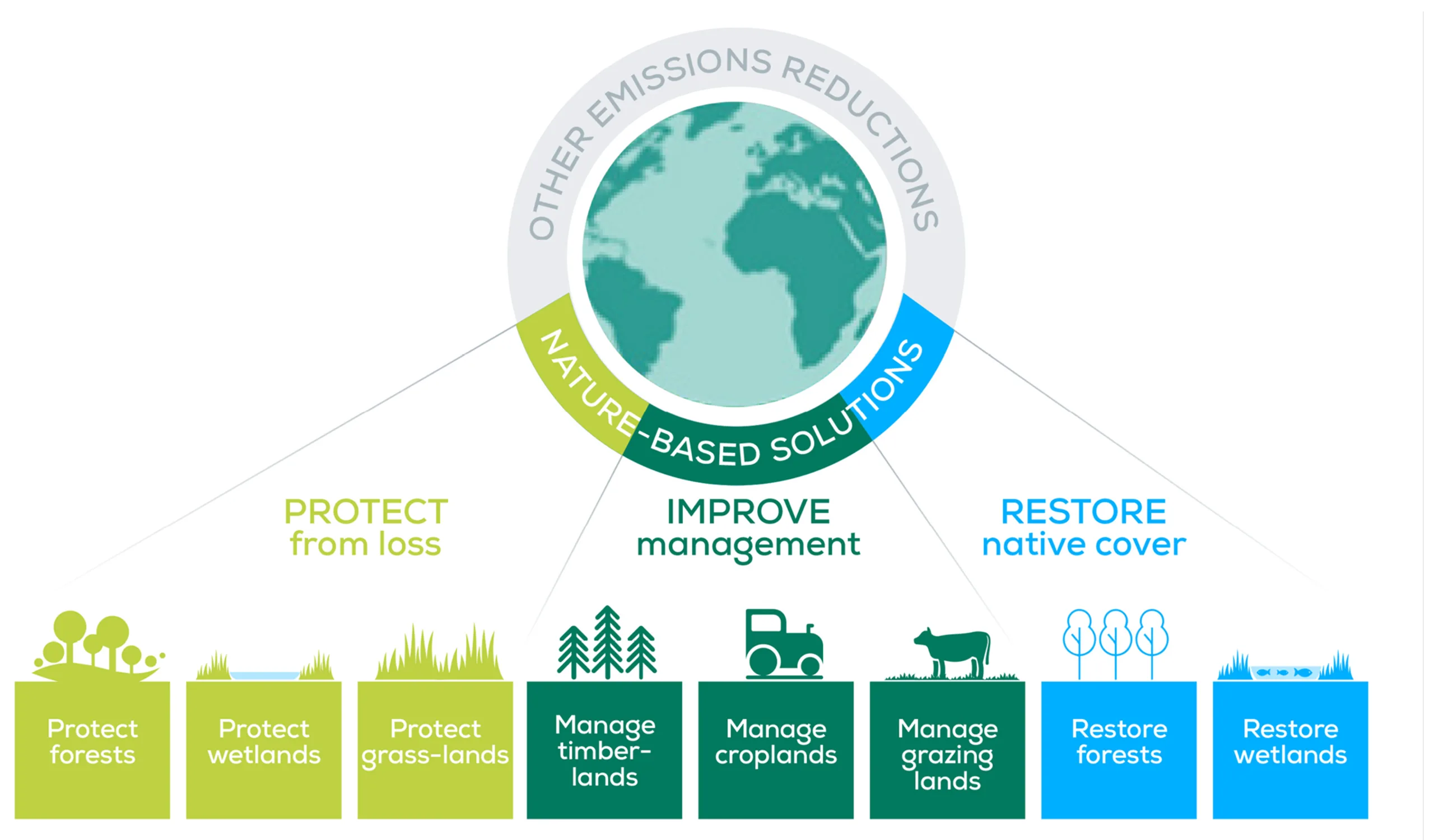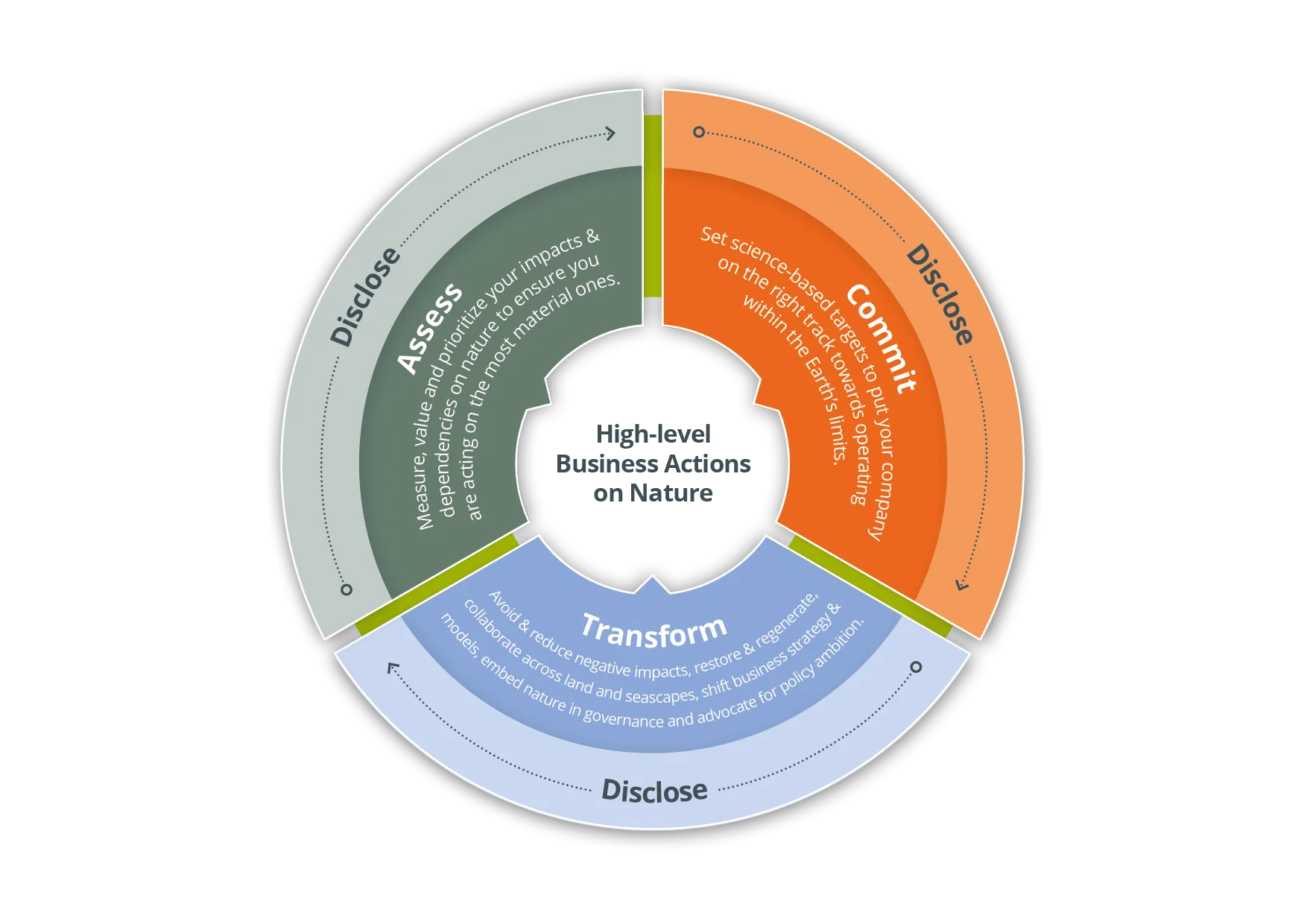Learn the foundations
Nature is a business imperative
Nature underpins the global economy – every business depends on it. Societies cannot survive, let alone prosper, without the essential services nature provides, including a stable climate and functioning ecosystems.
The challenge
Humanity is consuming double the resources that the Earth can regenerate each year. Associated land-use change (e.g., deforestation, urbanization) and sea-use change (e.g., aquaculture expansion, costal development), as well as pollution and greenhouse gas (GHG) emissions are driving record levels of nature loss, resulting in the greatest risks we face today.
The business risk
Nature loss is already impacting business and will pose increasing risks over time. Over half of global GDP depends moderately or highly on nature and its services. By 2050, a decline in ecosystem services such as pollination, water yield, coastal protection and carbon storage could result in losses of about 10% of global GDP.
Estimates show that more than 50% of the market value of companies listed on major stock exchanges is exposed to financial risk through ecosystem disruption.
The opportunity
Nature loss doesn’t only bring risks. A transition to a nature-positive economy can also unlock business opportunities.
By 2050, enhanced nature stewardship could add about USD $11.3 billion to global GDP per year. Examples include improving pollinator habitats, sustaining marine fish stocks, managing forests sustainably, and increasing carbon storage through reforestation and avoided degradation.
Understanding nature and its interconnected components
Understanding nature’s components and what’s driving nature loss is the basis for understanding business dependencies and impacts on nature.
The Nature Action Portal supports companies in exploring the most materials nature issues for the sector in which they operate. It helps them:
- Identify actions to halt and reverse nature loss;
- Choose metrics to measure and report on the impacts of the action taken.
Defining nature
Nature comprises all living plants, animals and fungi and their interactions with other living or non-living entities and processes across four realms.
- Nature realms: The land, ocean, freshwater and atmosphere realms include ecosystems (or biomes) such as tropical forests, grasslands, coral reefs, rivers and wetlands.
- Ecosystems & ecosystem services: Ecosystems are natural assets that provide ecosystem services that people and business rely on. These include, for example, climate regulation, freshwater for drinking and irrigation, and pollination.
- Biodiversity: Biological diversity – usually referred to as biodiversity – is the key indicator of the health of a system and refers to the variability among living organisms, within species (genetic diversity), between species (species diversity), and ecosystems (ecosystem diversity).
Defining the drivers of nature loss
The Intergovernmental Science-Policy Platform on Biodiversity and Ecosystem Services (IPBES) has identified the five main drivers of change in nature as part of the scientific Global Assessment on Biodiversity and Ecosystem Services published in 2019.
These have informed the development of key frameworks like the Science Based Targets Network (SBTN) methods, guidance and tools, and the recommendations of the Taskforce on Nature-related Financial Disclosures (TNFD). The five drivers of nature loss are:
- Land-, water-, sea-use change: The human-induced transformation of terrestrial, aquatic and marine environments through activities that alter their natural state, function or use. (See Glossary for more details on each area). Examples of human activities contributing to this driver include deforestation, urbanization, industrial water uptake, and coastal development.
- Resource exploitation: The process of removing living (e.g., plants, animals) and non-living (e.g., minerals, fossil fuels) materials from nature to meet human demands. This often involves the large-scale exploitation of natural resources, driven by population growth and rising consumption. When extraction exceeds sustainable levels, it leads to overexploitation – causing biodiversity loss, ecosystem degradation, and negative impacts on both nature and people. Examples of human activities contributing to this driver include unsustainably logging, overfishing, wildlife poaching, mining and quarrying.
- Climate change: A change in the state of the climate that can be identified (e.g., by using statistical tests) based on changes in the mean and the variability of its properties, and change that persists for an extended period, typically decades or longer. Examples of human activities contributing to this driver include burning fossil fuels, industrial processes and deforestation.
- Pollution: The introduction of contaminants into the natural environment that cause adverse change. Examples of human activities contributing to this diver include industrial emissions, agriculture runoffs and improper waste disposal.
- Invasive species: Species whose introduction and spread by human action outside their natural distribution threatens biological diversity, food security, and human health and well-being. Examples of human activities causing the spread of invasive species include global trade and transport, unsustainable agriculture and forestry, travel and tourism.
The diagram below illustrates the drivers of nature change and measurable impact drivers across the four realms of nature. The measurable impacts form the basis of the sector-level assessment of most material dependencies and impacts on nature available in the Nature Action Portal.
To learn more about the assessment of material dependencies and impacts on nature (STEP 1), refer to the Methodology page.
Drivers of nature change and measurable impact drivers (adapted from TNFD)

Nature and climate are interlinked
The atmosphere – one of nature’s four realms – forms a critical bridge between climate and the natural world. Continuous exchanges of greenhouse gases, water and energy across air, land, freshwater and ocean systems explain why nature regulates the climate and why climate change can drive nature loss.
For example, rising greenhouse gas levels are altering temperature and rainfall patterns, which in turn disrupt ecosystems, accelerating nature loss. Reducing greenhouse gas (GHG) emissions, restoring ecosystems, and protecting biodiversity are therefore mutually reinforcing goals: progress in one area strengthens the others.
Restoring and regenerating nature is essential for effective climate mitigation. Many approaches can generate benefits for climate, nature and equity at the same time. Nature-based Solutions stand out as a particularly powerful example.
As illustrated in the diagram below, this type of action focuses on protecting nature, improving management and restoring native cover, yielding benefits for both people and the environment.
It is estimated that nature-based solutions can deliver more than one-third of all climate mitigation actions needed to meet the Paris Agreement’s 1.5°C target.
The Kunming-Montreal Global Biodiversity Framework also recognizes the role of nature-based solutions in protecting 30% of land and sea by 2030 (30×30 target) and other targets focused on nature restoration, climate change adaptation, mitigation and disaster risk reduction (including targets 7 – Reduce Pollution to Levels That Are Not Harmful to Biodiversity – and 11 – Restore, Maintain and Enhance Nature’s Contributions to People).
However, nature-based solutions remain underfunded; instead, an estimated USD $7 trillion per year in annual finance flows from public and private sector sources have direct negative impacts on nature. Nature-based solutions represent a significant investment opportunity for businesses looking for cost-effective actions with multiple benefits.
The Portal helps users explore some of these actions and metrics to measure impact and progress.
Nature-based solutions (adapted)

Embedding nature into corporate strategies
Stakeholders widely acknowledge the term “nature positive” as a global goal to halt and reverse nature loss by 2030 and achieve full recovery by 2050, as captured in the mission statement of the Kunming-Montreal Global Biodiversity Framework.
All actors of society, including individual companies, contribute to this shared goal through actions to reduce or mitigate the negative impacts of their business activities on nature, as well as through actions to restore and regenerate nature – in line with SBTN’s Action Framework (AR3T).
Companies should apply such actions systematically across their spheres of control and influence, from direct operations (e.g., sites and operational decisions) to priority parts of their supply chains and adjacent landscapes (e.g., priority locations of biodiversity importance).
To actively contribute to system change, companies should also look to use their influence to transform them through engagement on policy, with peers and beyond.
Spectrum of influence and control across nature-related domains (adapted from SBTN)

The high-level business actions (usually referred to as ACT-D – Assess, Commit, Transform and Disclose) underpin all key business-related frameworks in the Nature Action Portal.
Developed by WBCSD, Business for Nature (BfN), the Capitals Coalition, the Science Based Targets Network (SBTN), the Taskforce on Nature-related Financial Disclosures (TNFD), the World Economic Forum and the Worldwide Fund for Nature (WWF), the ACT-D framework informed the initial Roadmaps to Nature Positive, first launched in 2022.
The series of system and sector-specific Roadmaps use a collaborative process, bringing together peers from the same sector or economic system to define a shared agenda and the activities that will accelerate credible nature-positive action and accountability.
Building on this approach, we produced guidance on nature actions available for 15+ sectors in collaboration with Business for Nature and the World Economic Forum. More recently, we also supported the Business for Nature coalition with the development of the Nature Strategy Handbook, a practical guide to support all businesses in developing a nature strategy.
The Handbook builds on guidance from the ACT-D High-Level Business Actions on Nature to show the key components of a credible nature strategy, taking into account the requirements of various frameworks, guidance and regulations.
ACT-D framework

To learn more about the Roadmaps to Nature Positive, please refer to the Methodology page.
